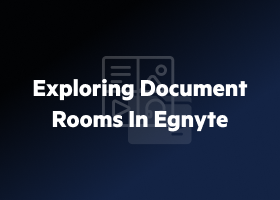Secure Deal Management for Life Sciences with a Virtual Data Room
Let’s jump in and learn:
- Streamlining Life Sciences Deal Management: The Power of Document Room
- Life Sciences Requirements Driving the Need for Document Rooms
- What Is a Document Room?
- Virtual Data Room: A Modern Solution
- Key Features of Document Rooms for Life Sciences
- Advantages of Using Virtual Data Rooms in Life Sciences
- Choosing the Right Virtual Data Room Provider
- Implementing a Virtual Data Room: Best Practices
- Life Sciences Organizations Choose Virtual Document Room Solutions
Streamlining Life Sciences Deal Management: The Power of Document Room
This Egnyte Governance Guide outlines the general data protection capabilities available for Virtual Data Room solutions, when they are deployed for Life Sciences use-cases. If you’re looking for specific information about Egnyte’s Document Room solution, you can find it here
The life sciences industry is a broad sector that includes large subcategories, such as biotechnology, medical devices, pharmaceuticals, and a number of other medical and healthcare services and solutions. Across all subcategories, the life sciences industry produces and collects vast amounts of sensitive information. This information demands protection not just to ensure compliance with numerous regulations (e.g., HIPAA and GDPR), but also to protect valuable proprietary research and trade secrets.
Document management is of the utmost importance across all parts of the life sciences industry. Already a difficult and tedious function, document management becomes even more challenging when life sciences organizations need to share sensitive information during investments and fundraising. To address these challenges, life sciences organizations leverage document rooms and are increasingly using virtual document rooms.

Life Sciences Requirements Driving the Need for Document Rooms
Several scenarios commonly require life sciences organizations to share sensitive information. The most common are during clinical trials and due diligence related to mergers and acquisitions, auditing, drug licensing, and investment fundraising. Among the many issues that must be addressed to share sensitive information safely are the following.
Collaboration
Life sciences companies rely on a complex web of collaboration stakeholders to conduct their work. For example, a clinical trial involves a large group that must share highly sensitive information.
Compliance
Regulatory requirements require life sciences companies to ensure the confidentiality, integrity, and availability of sensitive information. With the number of stakeholders that require access to this data, making it available as efficiently as possible while adhering to multiple regulatory standards and laws is extremely complex.
Data security
All sensitive information that a life sciences company shares requires strong protection from unauthorized access and tampering. This can include data ranging from patient information and study results to product pricing and strategic partnerships.
Efficiency
While meeting the many requirements to comply with regulations and protect proprietary information, life sciences companies still need to make copious amounts of data readily available to their authorized stakeholders. This is of particular importance with clinical trials, drug licensing, mergers and acquisitions, and IPOs.
What Is a Document Room?
A document room is a secure place where sensitive documents are stored and shared during the course of a transaction or project, such as a merger and acquisition negotiation or investments and fundraising in the case of life sciences. Within a document room, sensitive information and confidential documents can be kept and made available based on authorization.
Traditionally, document rooms were literally physical spaces filled with documents and areas for authorized visitors to review them, usually after having signed Non-Disclosure Agreements (NDAs). These rooms were protected with physical security, security personnel, and monitoring systems (e.g., security cameras).
In addition to being a secure space, traditional document rooms provided:
- Access controls to ensure security and confidentiality and prevent unauthorized parties from entering
- Centralized storage of relevant documents to make them easily accessible to those with authorization, as well as to facilitate document management
- Records of who accessed what documents and when to provide an audit trail
While traditional document rooms were effective for a long time, they had significant limitations and issues. For instance, physical documents stored in a room were susceptible to damage and could be discretely photographed by reviewers. Perhaps more important were the inherent limitations of physical documents, such as the difficulty of sharing them with people in different locations, challenges related to access control, and difficulty with document management as the volume of records grew.
Virtual Data Room: A Modern Solution
Modern document rooms are delivered to users digitally. Virtual document rooms, also referred to as virtual data rooms, replace physical spaces with confidential online spaces that offer the core functionality of their physical counterparts but with many more management capabilities and all of the benefits of virtual environments.
Virtual document rooms provide life sciences organizations with a secure space for teams to share, track, and manage sensitive information, such as research, clinical trial data, regulatory filings, intellectual property documents, and financial information. These modern document rooms also offer enhanced security features, such as granular access control, data encryption, and detailed audit trails that capture everything that happens to a document (e.g., users’ access, document changes, and sharing activity).
Key Features of Document Rooms for Life Sciences
Advantages of Using Virtual Data Rooms in Life Sciences
Virtual document rooms offer powerful functionality that addresses the specific needs of life sciences organizations. The following list recaps the main benefits that virtual document rooms deliver.
- Advanced analytics that monitor document engagement, time spent with each document, and other user activity
- Data protection to ensure the confidentiality and integrity of sensitive life sciences data
- Deal progress monitoring through a unified dashboard accessible to all stakeholders regardless of their location
- Document management makes it easy to organize many types of documents in a secure, centralized hub
- Accelerate fundraising by enabling secure, centralized document sharing for enhanced collaboration among all stakeholders
- Integration with tools and platforms that are already deployed by the organization
- Scalable storage that can be adjusted based on project demands
- Support for compliance efforts
Use Cases in Life Sciences
Clinical trials
During clinical trials, life sciences organizations collect vast amounts of highly sensitive information that must be shared with a number of stakeholders. A virtual document room provides a secure and streamlined solution for sharing sensitive medical information with patients, researchers, and regulatory authorities involved in all phases of clinical trials.
Investment fundraising
During investment fundraising initiatives, a virtual document room helps life sciences organizations efficiently organize and present documents. Virtual document rooms’ indexing capabilities streamline document retrieval. They also enable digital document signing to expedite approvals and provide an audit trail of who reviewed and signed which documents and when. Virtual document rooms also give life sciences teams valuable insight into specific areas of interest for particular investors with detailed reports that show how much time investors spent reviewing particular documents.
Initial Public Offerings (IPOs)
Preparing for a life sciences IPO requires vast numbers of financial, legal, and due diligence documents to be organized and made available to a broad range of stakeholders. The centralized repository and access controls provided with virtual document rooms facilitate this. In addition, many life science companies use virtual document rooms to track tasks and milestones and manage regulatory communications.
Mergers & Acquisitions (M&A) due diligence
The life sciences industry conducts many M&A transactions. Virtual document rooms facilitate every stage of due diligence during M&A transactions. They centralize sensitive documents in a secure repository that allows all authorized parties to access relevant documents without exposing sensitive information to unauthorized users. In addition, virtual document rooms enable customized enforceable NDAs, T&C, and other agreements for better compliance.
Licensing
During IP licensing deals, life sciences firms can use virtual document rooms to ensure the secure handling of sensitive information. Virtual document rooms offer granular access controls to restrict document access to approved parties only. In addition, life sciences teams can share access to documents with multiple potential partners without any of them knowing the other is also reviewing the same documents.
Choosing the Right Virtual Data Room Provider
The success of a virtual data room implementation is largely determined by the solution that is selected. There are a number of options available to suit the nuanced requirements of different organizations.
Life sciences organizations are encouraged to take time to conduct a comprehensive assessment of the user and stakeholder requirements and evaluate how each system’s capabilities and services align with those needs. The following are several important considerations that apply broadly to life sciences organizations.
Ease of use
In addition to being straightforward to implement, a virtual document room solution should have a user-friendly interface and extensive automated functionality.
Compliance
A virtual document room solution must provide functionality to support compliance and have certifications to validate vendors’ promises. This includes security, privacy, and reporting capabilities to adhere to the many standards and regulations that apply to the life sciences industry, such as HIPAA, GDPR, ALCOA+ and various ISO standards.
Usage tracking
Detailed audit trails that track access and usage are critical for a life sciences organization’s virtual document room. This functionality not only supports compliance but also helps to improve accuracy and provide traceability.
Support
The support services offered by a virtual document room provider need to align with a life sciences organization’s resources. Those with limited support staff or global teams need to consider the availability of 24/7 support. Another consideration based on available resources is what implementation services are available.
Security
Regardless of size, every life sciences company requires robust security for its virtual document room to protect sensitive information. Security capabilities to closely assess are data protection, access control, and data loss prevention.
Reviews
When considering options for a virtual document room, reviews by other life sciences companies are extremely valuable. These reviews can provide insights based on real-world experiences as well as point to areas that should be added to the assessment criteria or that require more in-depth analysis.
Trials
Before committing to a virtual data room, it is best to try it to get a first-hand look at how it performs. Virtual document room providers with proven track records are most often more than willing to offer a free trial.
Implementing a Virtual Data Room: Best Practices
The following are several key considerations and best practices when implementing a virtual data room:
- Assess the organization’s use case(s).
- Assign an administrator to oversee implementation and maintenance of the virtual document room.
- Conduct regular audits of the virtual document room to identify and address any potential security vulnerabilities or breaches.
- Develop a user-friendly core folder structure for storing documents that will scale as additional documents are added.
- Evaluate virtual document room solutions to find which align with the organization’s specific needs and resources.
- Implement version control processes to ensure that everyone is working with the most up-to-date documents (e.g., when a document is updated, the previous version should be indexed and potentially archived).
- Monitor activity in the virtual document room.
- Organize the documents that will be stored in the virtual document room.
- Provide thorough training to all users who will be using the virtual data room.
- Set up security controls, including access policies and monitoring.
- Train users on how to use the virtual document rooms’ features as well as how to maintain the folder structure and name documents.
Understand the virtual document room solution provider’s backup and business continuity disaster recovery (BCDR) capabilities.
Life Sciences Organizations Choose Virtual Document Room Solutions
To effectively address the many challenges and expanding volume of sensitive documents and data that must be shared, virtual document rooms have generally replaced their physical predecessors. The move to a virtual document room model has been fast and has broad adoption because of the security, accessibility, efficiency, and legal benefits provided by them. While there may be limited scenarios that warrant a physical document room, the vast majority of today’s use cases are best supported with a virtual document room.
Egnyte has experts ready to answer your questions. For more than a decade, Egnyte has helped more than 22,000+ customers with millions of users worldwide.
Additional Resources

Egnyte Document Rooms Improve Productivity and Cybersecurity
Today’s companies need to collaborate with global partners and share sensitive data, which forces them ...

Exploring Document Rooms In Egnyte
How-to videos and product documentation are great ways to learn how to establish a secure foundation ...

Egnyte Document Room
Protect and manage highly sensitive business information.